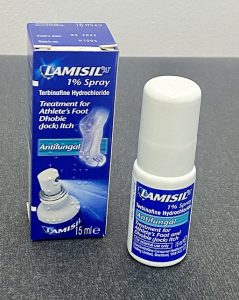12.4 Other Antimicrobial Medications
Antiviral Medications
Similar to antibacterial medications, antiviral medications directly impact the interaction and reproduction of the invading microorganisms. Antibacterial medications are required for treating bacterial infections, whereas antivirals treat specific viral infections. For example, oseltamivir (Tamiflu) is commonly prescribed to treat influenza. Unlike antibiotics, antiviral medications do not kill the offending virus, but they work to reduce the replication and development of the virus (Parker et al., 2016).
Unlike the complex structure of fungi or protozoa, viral structure is simple. There are several subclasses of antiviral medications: anti-influenza, anti-herpes, anti-hepatitis, and antiretrovirals.
Anti-Influenza Medications
Oseltamivir (Tamiflu) targets the influenza virus by blocking the release of the virus from infected cells (Fig. 12.5). This medication does not cure influenza but can decrease influenza symptoms and shorten the duration of illness if taken in a timely manner. Patients are prescribed the medication as prophylaxis against infection or known exposure, or to shorten the course of the illness. If patients experience flu-like symptoms, it is critical that they start treatment within 48 hours of symptom onset.

The following are medications used to treat influenza virus infections (influenza A or influenza B) (WebMD, 2023):
- amantadine (Symmetrel)
- influenza virus vaccine (Fluarix, FluMist)
- oseltamivir (Tamiflu)
- rimantadine (Flumadine)
- zanamivir (Relenza)
Key Concept
Flu vaccinations are given prophylactically to prevent influenza. The vaccine uses either the whole virus, part of the virus, or a surface antigen from the virus to provoke the body’s immune response and create temporary immunity. Annual revaccination is necessary to provide protection against the most current strains of the two most common and dangerous flu families—influenza A and influenza B viruses.
Anti-Herpes Medications
Acyclovir (Zovirax) and its derivatives are frequently used to treat herpes and varicella virus infections, including genital herpes, chickenpox, shingles, Epstein-Barr virus infections, and cytomegalovirus infections (Fig. 12.6). Acyclovir causes termination of the DNA chain during the viral replication process. It can be administered either topically or systemically, depending on the infection.

Anti-Hepatitis Medications
Hepatitis, or inflammation of the liver, can be complicated to treat, and the choice of treatment will vary depending on the causative factor (A, B, or C). Hepatitis can be caused by toxins, medications, and viruses.
Medications for hepatitis virus infections (hepatitis A, hepatitis B, or hepatitis C) include the following (WebMD, 2023):
- adefovir (Hepsera)
- entecavir (Barclude)
- interferon alfa-2b (Intron A)
- interferon alfacon-1 (Infergen)
- lamivudine (Epivir)
Antiretroviral Medications
Viruses with complex life cycles, such as human immunodeficiency virus (HIV) and the condition it can result in, acquired immunodeficiency syndrome (AIDS), can be difficult to treat. These types of viruses require the use of antiretroviral medications that block viral replication. Many antiretrovirals may impact renal function; therefore, the patient’s urine output and renal labs should be monitored carefully for signs of decreased function.
Antifungal and Yeast Infection Medications
Antifungals, or antimycotic agents, are medications used to treat fungal infections. They work by killing the cells of the fungus or inhibiting cell reproduction. Unlike antibacterial and antiviral medications, many antifungals are applied topically to the affected area. Fungal infections commonly affect surface areas of the body, including the toes, nails (onychomycosis) , mouth, and groin, as well as the skin. For example, Candida albicans is a type of fungus that when overgrown in the mouth produces oral thrush. Patients experiencing thrush may be prescribed an oral antifungal “swish and spit” medication such as nystatin.
Imidazoles are synthetic fungicides commonly used in medical applications, but they are also used in agriculture to keep seeds and harvested crops from moulding. Examples include miconazole (Monistat), ketoconazole (Nizoral), and clotrimazole (Lotrimin), which are used to treat fungal skin infections such as ringworm, tinea pedis (athlete’s foot), tinea cruris (jock itch), and tinea corporis (Fig. 12.7).

Triazole medications, including fluconazole (Diflucan), can be administered orally or intravenously for the treatment of several types of systemic yeast infections, including oral thrush and cryptococcal meningitis, both of which are prevalent in patients with AIDS (Parker et al., 2016).

Key concept
A common suffix found with a couple of the antifungal medications is -conazole.
Examples: ketoconazole (Nizoral), fluconazole (Diflucan)
Allylamines, a structurally different class of synthetic antifungal drugs, are most commonly used topically for the treatment of skin infections like athlete’s foot, ringworm, and jock itch (Fig. 12.8). Oral treatment with terbinafine (Lamisil) is also used for fingernail and toenail fungus (onychomycosis) (Parker et al., 2016).
Polyenes are another class of antifungal agents and are naturally produced by certain soil bacteria. Common examples include nystatin (Mycostatin) and amphotericin B (Fungizone). Nystatin is typically used as a topical treatment for yeast infections of the skin, mouth, and vagina, but may also be used for intestinal fungal infections. Amphotericin B is used for systemic fungal infections such as aspergillosis, cryptococcal meningitis, histoplasmosis, blastomycosis, and candidiasis. It was the only antifungal medication available for several decades, but its use has serious side effects, including renal toxicity (Parker et al., 2016).
Medications for systemic fungal infections (WebMD, 2023):
- amphotericin B (Fungizone)
- capofungin (Cancidas)
- terbinafine (Lamisil)
Medications for yeast infections (WebMD, 2023):
- fluconazole (Diflucan)
- nystatin (Mycostatin, Nystatin Cream)
- flucytosine (Ancobon)
Table 12.2. Common Anti-Viral & Anti-fungal Yeast Medications
| Generic Name | Trade Name | Reason for Administering |
| amantadine | Symmetrel | Influenza virus infection |
| influenza virus vaccine | Fluarix, FluMist | Influenza virus infection |
| oseltamivir | Tamiflu | Influenza virus infection |
| rimantadine | Flumadine | Influenza virus infection |
| zanamivir | Relenza | Influenza virus infection |
| acyclovir | Zovirax | Herpes infection |
| adefovir | Hepsera | Hepatitis infection |
| entecavir | Barclude | Hepatitis infection |
| interferon alfa-2b | Intron A | Hepatitis infection |
| interferon alfacon-1 | Infergen | Hepatitis infection |
| lamivudine | Epivir | Hepatitis infection |
| clotrimazole | Lotrimin | Fungal skin infection |
| miconazole | Monistat | Fungal skin infection |
| amphotericin B | Fungizone | Systemic fungal infection |
| capofungin | Cancidas | Systemic fungal infection |
| ketoconazole | Nizoral | Systemic fungal infection |
| terbinafine | Lamisil | Systemic fungal infection |
| fluconazole | Diflucan | Yeast and fungal infections |
| flucytosine | Ancobon | Yeast infection |
| nystatin | Mycostatin, Nystatin Cream | Yeast infection |
(WebMD, 2023)
Attribution
Unless otherwise indicated, material on this page has been adapted from the following resource:
Ernstmeyer, K., & Christman, E. (Eds.). (2020). Nursing pharmacology. Chippewa Valley Technical College. https://wtcs.pressbooks.pub/pharmacology/, licensed under CC BY 4.0
References
Parker, N., Schneegurt, M., Thi Tu, A.-H., Lister, P., & Forster, B. M. (2016). Microbiology. OpenStax. https://openstax.org/details/books/microbiology?Book%20details, licensed under CC BY 4.0
WebMD. (2023). Drugs & medications A–Z. https://www.webmd.com/drugs/2/index
Image Credits (images are listed in order of appearance)
A Tamiflu (oseltamivir) capsule by Mk2010, CC BY-SA 4.0
Zovirax, packaging Wellcome L0067161 by Wellcome Images, CC BY-SA 4.0
Canesten by Editor182, Public domain
Terbinafine spray by Whispyhistory, CC BY-SA 4.0
fungal infection of the nail
superficial skin infection

